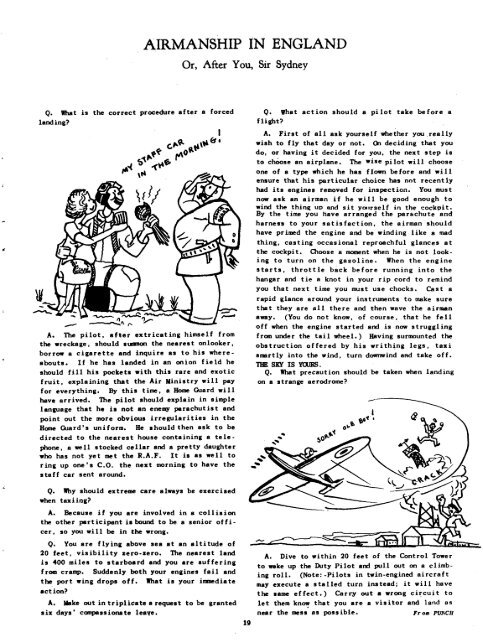News Letter 1941 Jul-Dec - Air Force Historical Studies Office
News Letter 1941 Jul-Dec - Air Force Historical Studies Office
News Letter 1941 Jul-Dec - Air Force Historical Studies Office
Create successful ePaper yourself
Turn your PDF publications into a flip-book with our unique Google optimized e-Paper software.
AIRMANSHIP<br />
IN ENGLAND<br />
Or, After You, Sir Sydney<br />
Q. What is the correct procedure after a forced<br />
landing?<br />
A. The pilot. after extricating himself from<br />
the wreckage, should summon the nearest onlooker,<br />
borrow a cigarette and inquire as to his whereabouts.<br />
If he has landed in an onion field he<br />
should fill his pockets with this rare and exotic<br />
fruit, explaining that the <strong>Air</strong> Ministry will pay<br />
for everything. By this time, a Home Guard will<br />
have arrived. The pilot should explain in simple<br />
language that he is not an ene~ parachutist and<br />
point out the more obvious irregularities in the<br />
Home Guard's uniform. He should then ask to be<br />
directed to the nearest house containing a telephone,<br />
a well stocked cellar and a pretty daughter<br />
who has not yet met the R.A.F. It is as well to<br />
ring up one's C.O. the next morning to have the<br />
staff car sent around.<br />
Q. Why should extreme care always be exercised<br />
when taxiing?<br />
A. Because if you are involved in a collision<br />
the other participant is bound to be a senior off i-<br />
cer, so you will be in the wrong.<br />
Q. You are flying above sea at an altitude of<br />
20 feet, visibility zero-zero. The nearest land<br />
is 400 miles to starboard and you are suffering<br />
from cramp. Suddenly both your engines fail and<br />
the port wing drops off. What is your immediate<br />
action?<br />
A. Make out in triplicate a request to be granted<br />
six days' compassionate leave.<br />
19<br />
Q. What action should a pilot take before a<br />
flight?<br />
A. First of all ask yourself whether you ,really<br />
wish to fly that day or not. On deciding that you<br />
do, or having it decided for you, the next step is<br />
to chOose an airplane. The wise pilot will choose<br />
one of a type which he has flown before and will<br />
ensure that his particular choice has not recently<br />
had its engines removed for inspection. You must<br />
now ask an airman if he will be good enough to<br />
wind the thing UP and sit yourself in the cockpit.<br />
By the time you have arranged the par&chute and<br />
harnes~ to your satisfaction, the airman should<br />
have primed the engine and be winding like a mad<br />
thing, casting occasional reproachful glances at<br />
the cockpit. Choose a moment when he is not looking<br />
to turn on the gasoline. When the engine<br />
starts, throttle back before running into the<br />
hangar and tie a knot in your rip cord to remind<br />
you that next time you must use chocks. Cast a<br />
rapid glance around your instruments to make sure<br />
that they are all there and then wave the airman<br />
away. (You do not know, of course, that he fell<br />
off when the engine started and is now struggling<br />
from under the tail wheel.) Having surmounted the<br />
obstruction offered by his writh~ng legs, taxi<br />
smartly into the wind, turn downwind aAd take off.<br />
1HE SKY IS YClJRS.<br />
Q. What precaution should be taken when landing<br />
on a strange aerodrome?<br />
A. Dive to within 20 feet of the Control Tower<br />
to wake up the Duty Pilot and pull out on a climbing<br />
roll. (Note:-Pilots in twin-engined aircraft<br />
may execute a stalled turn instead; it will have<br />
the .ame effect.) Carr~ out a wrong circuit to<br />
let them kn~ that you are a visitor and land as<br />
near the mess allpossible. Frolll PUNCH
















